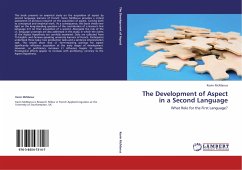
The Acquisition of English Short A and E by Second Language Learners
The Roles of Vowel Height, Duration and Task for German Learners of the English Short A and E Contrast
Versandkostenfrei!
Versandfertig in 6-10 Tagen
52,99 €
inkl. MwSt.

PAYBACK Punkte
26 °P sammeln!
A common problem for English as a Second Language (ESL) learners is producing Short A and E accurately and maintaining the contrast between them. Traditionally, vowel height has been considered to be a distinctive feature between vowels. Vowel duration and the voicing of consonants have been considered to be redundant features. It is unclear the extent to which vowel height, duration, word-final voicing, and attention to speech affect the accuracy of learners' Short A and E productions. This book provides a study that was conducted of 20 native German speakers in order to determine the role of...
A common problem for English as a Second Language (ESL) learners is producing Short A and E accurately and maintaining the contrast between them. Traditionally, vowel height has been considered to be a distinctive feature between vowels. Vowel duration and the voicing of consonants have been considered to be redundant features. It is unclear the extent to which vowel height, duration, word-final voicing, and attention to speech affect the accuracy of learners' Short A and E productions. This book provides a study that was conducted of 20 native German speakers in order to determine the role of distinctive and redundant features in their pronunciation of Short A and E. Vowel height, duration and the production of [t] and [d] were found to promote the L1 German speakers' production of the Short A and E contrast. The book will be of interest to ESL/EFL pronunciation specialists and anyone interested in the fields of Second Language Phonology and Second Language Acquisition. It will be useful for people who are interested in gaining an in-depth understanding of the complexity of English learners' pronunciation of Short A and E.












